Fish Of Saudi Arabia

The mainland of Saudi Arabia is largely covered by the Arabian Desert, and characterized by its barren landscapes. This arid desert environment lacks the lakes, rivers, and streams that are necessary for freshwater fish habitats. The country does, however, have long coastlines on both the Red Sea and the Persian Gulf. These waters host a variety of fish life, some of which are discussed below.
Goldsilk Seabream
Native to the Indian Ocean, the Acanthopagrus berda (commonly known as the Goldsilk Seabream) mainly inhabits shallow, muddy coastal waters. Young Goldsilk Seabream typically stay within bay areas. Their diet consists of worms, mollusks, crustaceans, and smaller fish. The commercial fishing industry, does not target these fish and no other major threats against them have been identified. Subsistence fishing practices may, however, result in overfishing. For this reason, South Africa has established a catch restriction of 5 fish per day. It is of “least concern” according to the IUCN Red List of Endangered Species.
Indian Threadfish
The Indian threadfish belongs to the Family Carangidae. It has been found from India to Australia, as well as off of the coast of Saudi Arabia. The adults typically live in reef areas below 65 feet. Unique in appearance, the Indian threadfish has an angular, almost geometric, shaped body. Predatory by nature, it feeds on jellyfish, squid, and small fish. This fish species is mainly targeted by small fishing ventures, although in Singapore it is commercially farmed. Archaeologists have found evidence of the Indian threadfish in ancient ruins in the United Arab Emirates, suggesting its importance to humans. Some people have also kept them in aquariums.
Red Sea Spiny Basslet
The Red Sea spiny basslet is a relatively new species belonging to the Ancanthoplesiops genus. These are very small, reef dwelling fish, characterized by their brown and white markings. Researchers discovered this species at depths of around 55 to 98 feet. They have not yet been evaluated by the IUCN, and do not pose a threat to human safety.
Persian Mullet
The Persian mullet fish is only known to exist in the Persian Gulf. This species populates shallow, coastal waters where it eats algae and small invertebrates. The commercial fishing industry does target this fish although, researchers have not determined that their population is threatened due to this activity. There are no specific conservation efforts in place to protect this particular species, however, some of its habitat has been protected as marine reserves.
Arabian Sand Diver
The Arabian sand diver is a fish endemic to the combined waters of the Persian Gulf, the Indian Ocean, and the Gulf of Oman. It lives in waters of around 6.5 feet in depth. Its body appears to be lengthy and it is characterized by a pointed head and jutting lower jaw. The males of this species are recognized by a row of several brown spots and 3 rows of light blue spots. These fish feed in small groups. Its name, sand diver, comes from its defensive action of diving into the sand when scared.
The waters off the coast of Saudi Arabia are teeming with marine life, including many other additional fish species. For a more complete look at the fish of Saudi Arabia, a list has been presented below.
The Fish Of Saudi Arabia
| Fish of Saudi Arabia | Scientific Name |
|---|---|
| Goldsilk Seabream | Acanthopagrus berda |
| Indian Threadfish | Alectis indica |
| Red Sea Spiny Basslet | Acanthoplesiops cappuccino |
| Persian Mullet | Liza persicus |
| Arabian Sand Diver | Trichonotus arabicus |
| Ilish | Tenualosa ilisha |
| African Pompano | Alectis ciliaris |
| Acanthobrama hadiyahensis | Acanthobrama hadiyahensis |
| Wahoo | Acanthocybium solandri |
| Blue Tilapia | Oreochromis aureus |











